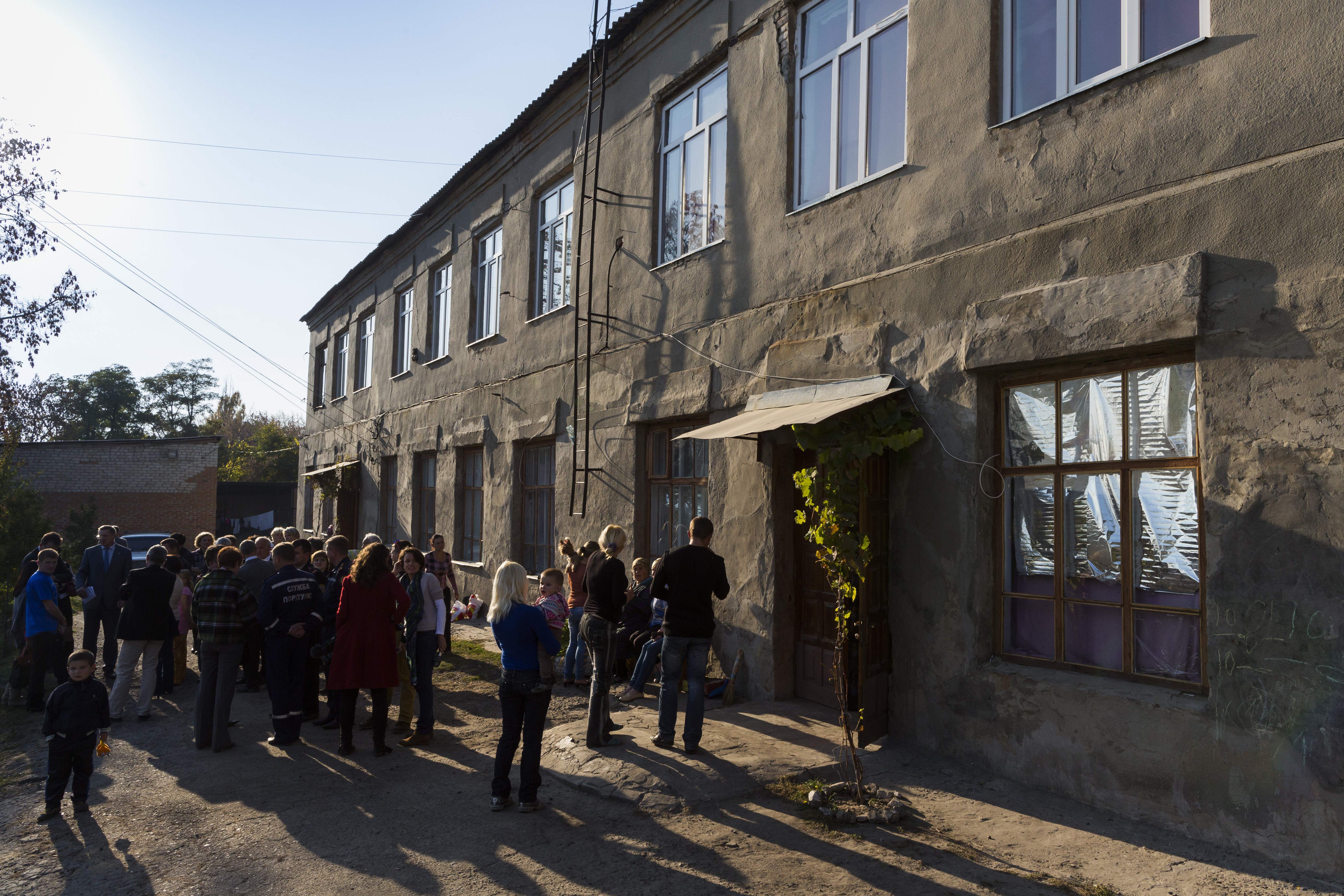War in Europe
Millions of internally displaced persons: How Ukraine Met the Major Humanitarian Challenge Caused by Russian Aggression

Refugee shelter of internally displaced persons in the eastern Ukrainian region of Kharkiv
© picture alliance / photothek | Thomas TrutschelOn February 24, 2022, the Russian Federation and Belarus as its accomplice unleashed a bloody war on the European continent. Ukraine had to concentrate all its efforts and resources to defend the country against the invaders and simultaneously also faced the greatest humanitarian challenge in its history.
Millions of people were forced to flee their homes, either running away from the combat actions that began in the very first hours of the invasion, or for fear of being occupied and tortured, abused, and murdered by Russian soldiers. According to estimates by both international organizations and Ukrainian officials, about 7-8 million Ukrainians were internally displaces persons (IDPs) in May 2022.
The first wave of IDPs and their needs
These millions of people moved to safer regions in a very short period of time during the first weeks of aggression. In the vast majority of cases, people took with them a minimum of the most necessary personal things. All their efforts were concentrated on meeting basic human needs: finding housing in safe regions, providing themselves with food and hygiene supplies, necessary medicines, food for pets, clothing (the beginning of the invasion was in late winter, and already after a month the winter clothes were not suitable for the weather), etc.
Under these conditions, Ukrainian civil society showed an incredible level of solidarity and self-organization, and in cooperation with local government, worked together to assist everyone in need. Local governments helped people obtain free housing in dormitories, recreation centers, schools, etc. Volunteer organizations provided IDPs with necessary humanitarian aid in the form of food and other everyday goods. People supported their fellow citizens to the best of their abilities: local businesses provided their premises as temporary housing, and local residents donated money, goods and joined in various work to help the IDPs.
Important steps were also taken by the central government. Monthly payments were provided for each officially registered IDP, and separate payments were handed out to families with children and people with disabilities. In addition, people who were officially employed also received assistance from the state in the amount of the minimum wage. All of this helped people cover some of their expenses, so that their personal financial savings were sufficient for a longer period.
Of course, it was not entirely smooth sailing. Although the Ukrainian state had considerable experience working with IDPs (as of April 2020, there were about 1,4 million IDPs registered in Ukraine who had moved from Russian-occupied Crimea and the occupied areas of Donetsk and Luhansk oblasts), the information systems of the corresponding government agencies were not designed to handle information about so many new people at once. Therefore, software often malfunctioned, and several attempts were required for people to register as IDPs.
However, these occasional bureaucratic difficulties seem insignificant when compared to just how many people who fled the horrors of war, often spending several days on the road, ended up receiving safe housing and all the help they needed from their fellow citizens. Tragically, not everyone was so fortunate. Today in many Ukrainian cities, you can see the shelled cars of people who evacuated from the war zone. And many people did not manage to get to their destination at all, because Russian soldiers destroyed civilian vehicles and killed passengers.
Nevertheless, Ukrainians generally managed to help the first wave of IDPs, while simultaneously fighting back the invader.
How the dynamics of combat actions influenced the problems faced by IDPs
In March-April, there were changes in the dynamics of combat operations that affected IDP issues. On the one hand, the Ukrainian army completely liberated Zhytomyr, Kyiv, Chernihiv, and Sumy regions from the occupants in April. This allowed many people to return home, which is what they had been waiting for for more than a month. According to Kyiv mayor Vitaly Klitschko, as of May 10, there were already 2.5 million residents in Kyiv (2/3 of the number before the Russian invasion). The Ukrainian Armed Forces also pushed Russian troops north of Kharkiv, and after that, a large number of Kharkiv residents began to return home.
On the other hand, it became obvious that many IDPs would not be able to return in the near future. In Kyiv the scale of destruction was relatively low, but small towns and villages in regions of Northern Ukraine suffered to a great extent, and sometimes were destroyed almost entirely. Residents of Donetsk and Luhansk regions also cannot return home any time in the foreseeable future because the Russian army used a scorched-earth tactic: they destroyed settlements completely with artillery and aviation and tried to seize them with ground forces afterwards. The Ukraine-controlled settlements of the Mykolaiv, Zaporizhzhya, and Kharkiv regions are also under constant fire, and because of the shortage of heavy weapons, it is not clear when the occupied parts of these regions could be liberated.
It became clear in April-May that Ukraine was capable of effectively defending itself, but it lacked the firepower to expel the invaders from its territory completely. The war has begun to take on a long-term character. Many people are forced to change their place of residence for a long time.
In the first weeks of the invasion, the situation seemed extremely uncertain, and therefore, no one made plans for the future, not even for a few days ahead. People just cared about saving their lives here and today. However, now, after the initial shock has passed, and the basic short-term needs of IDPs were met, it is time to consider the long-term problems of IDPs.
What are the most important long-term problems faced by IDPs?
A study, conducted by the Democratic Initiatives Foundation with the support of the Friedrich Naumann Foundation, revealed that employment is perhaps the most important challenge that IDPs face. This makes sense, since employment allows people to have financial resources to satisfy other needs.
According to a DIF quantitative survey among IDPs in western regions of Ukraine in March-April, 52% of IDPs either lost their jobs after the Russian invasion or do not receive their salaries even if the employment is officially preserved.
The same survey showed that the majority of IDPs had savings for at most six months. Given that the war lasts for more than 3 months already, people's savings are slowly running out. Indeed, state payments for IDPs and volunteer support have contributed to slowing down the spending of savings that IDPs had previously accumulated. However, this cannot last forever and people need sources of income to maintain themselves.
Employment also has a therapeutic effect in a psycho-emotional sense. In a state of anxiety and physical threat, people spend an extremely large amount of time reading the news, which only exacerbates anxiety. Work helps to mentally distract and shift attention to other things. Moreover, having a job strengthens a person's sense of belonging to a common goal. Working for the good of the country's economy, a person feels his or her involvement in the common victory over the enemy, which also helps to combat anxiety.
Finally, having a job adds to a person's self-confidence. Earning money makes one less dependent on the help of others and gives a person a greater sense of control over his or her life. This confidence encourages people to stay in their country in times of need and build their lives here, rather than emigrate abroad. Not to mention how important citizens’ employment is to the economy as a whole.
Revitalizing the economy during wartime: more questions than answers
The more global question of how to revitalize the economy during the war and the question of the country's post-war reconstruction is also on the table. A number of difficult questions need to be answered. How can we support the entrepreneurs in the liberated territories whose enterprises' physical assets have been affected by the combat actions? Is it possible to retain investors in a country where a Russian missile can strike your facility at any moment? How to find a balance between freedom for business and filling the state budget? How can citizens be encouraged to acquire new professions that are in demand in the labor market?
Ukraine today is in a unique situation in which systemic reforms must be carried out simultaneously with military action against a powerful enemy. The success of these reforms will also determine whether we can solve the humanitarian problems of millions of IDPs inside the country and whether we can succeed in the armed struggle, because a strong army needs a strong economy.
And finally, we should not forget that the most reliable tool for solving the humanitarian crisis is to provide Ukraine with weapons. The more weapons Ukraine has, the sooner we will liberate our territory and the people will finally be able to return home.
Serhii Shapovalov, Analyst at Ilko Kucheriv Democratic Initiatives Foundation (DIF)
